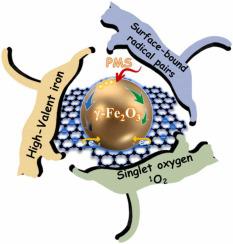Journal of Hazardous Materials ( IF 13.6 ) Pub Date : 2022-09-27 , DOI: 10.1016/j.jhazmat.2022.130070 Tingting Lian 1 , Yang Wang 1 , Baile Wu 1 , Fan Yang 1 , Nadezda V Tarakina 1 , Markus Antonietti 1

|
Advanced oxidation processes (AOP) are a common tool to remove organic compounds from the water cycle. The process is mostly relied on free radicals (i.e., SO4•− and HO•) with high oxidation power in solution. Surface-mediated mechanism could improve this process to prevent undesired quenching of aqueous radicals that widely exists in free radical pathways and alleviate metal leaching through direct electron transfer. In this work, a facile low-temperature pre-treatment combined with pyrolytic strategy was employed to construct a green catalyst with iron oxides embedded in Kraft-lignin derived bio-char (γ-Fe2O3 @KC), upon which radicals stay surface mediated and the activity-stability trade-off is achieved for pollutant degradation. The γ-Fe2O3 @KC is capable of activating PMS to generate non-radical species which are more stable (1O2 and Fe(V)=O) and of enhancing electron transfer efficiency. A surface-bound reactive complex (Catalyst-PMS*) was identified by electrochemical characterization and was discussed with primary surface-bound radical pairs to explain the contradictions between quenching and EPR detection results. We analyzed the γ-Fe2O3 @KC as a PMS-activating catalyst for a wider range of oxidation targets, such as Rhodamine B (∼100%), p-nitrophenol (∼85%), and Ciprofloxacin (∼63%), and found competitive removal efficiencies. The system also shows an encouraging reusability for at least 5 times and high stability at pH 3–9, and the low concentration of iron in γ-Fe2O3 @KC/PMS system implies the carbon scaffold of biochar alleviate the leakage process. The combined findings highlight the applicability in ‘green (source) to green (application)’ processes using cost-effective and bio-friendly iron@carbon catalysts, where alternative oxidation pathways are activated to play a dominant role for water purification.
中文翻译:

“绿色到绿色”:嵌入木质素基碳支架中的氧化铁通过氧化修复水,不包括自由基途径
高级氧化工艺 (AOP) 是从水循环中去除有机化合物的常用工具。该过程主要依赖于溶液中具有高氧化能力的自由基(即SO 4 • -和HO•)。表面介导的机制可以改善这一过程,以防止自由基途径中广泛存在的水性自由基发生不希望的猝灭,并通过直接电子转移减轻金属浸出。在这项工作中,采用简便的低温预处理与热解策略相结合,构建了一种绿色催化剂,其中氧化铁嵌入牛皮纸木质素衍生的生物炭(γ-Fe 2 O 3@KC),在此基础上,自由基保持表面介导,并实现了污染物降解的活性-稳定性权衡。γ-Fe 2 O 3 @KC 能够激活PMS 以产生更稳定的非自由基物质( 1 O 2和Fe(V)=O) 并提高电子转移效率。通过电化学表征鉴定了一种表面结合的反应性复合物 (Catalyst-PMS*),并与主要的表面结合自由基对进行了讨论,以解释猝灭和 EPR 检测结果之间的矛盾。我们分析了γ-Fe 2 O 3@KC 作为 PMS 活化催化剂用于更广泛的氧化目标,例如罗丹明 B(~100%)、对硝基苯酚(~85%)和环丙沙星(~63%),并发现具有竞争力的去除效率。该系统还显示出令人鼓舞的至少 5 次可重复使用性和在 pH 3-9 下的高稳定性,并且 γ-Fe 2 O 3 @KC/PMS 系统中的低铁浓度意味着生物炭的碳支架减轻了泄漏过程。综合研究结果突出了使用具有成本效益和生物友好的铁@碳催化剂在“绿色(来源)到绿色(应用)”过程中的适用性,其中替代氧化途径被激活以在水净化中发挥主导作用。



























 京公网安备 11010802027423号
京公网安备 11010802027423号